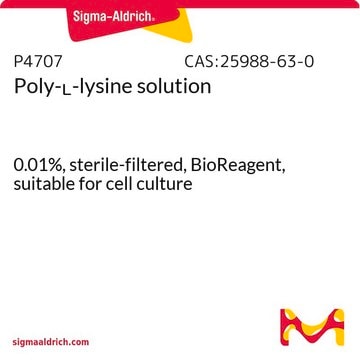Solutions of this product are not sterile and contain a preservative, ProClin, to control contamination. In theory you could sterile filter P8920 through low protein binding filters, such as PVDF or PES. Sterile filtering will not remove the ProClin from P8920. Live cells should not be exposed to ProClin, as ProClin interrupts the Krebs cycle at 4 different sites. It would be best to purchase the powder as P1524 and then sterile filter after the solution has been prepared.
推荐产品
生物来源
synthetic
保质期
Expiry date on the label.
分子量
150,000-300,000
浓度
0.1 % (w/v) in H2O
颜色
colorless
应用
hematology
histology
储存温度
room temp
SMILES字符串
N([C@@H](CCCCN)C(=O)N[C@@H](CCCCN)C(=O)O)C(=O)[C@@H](N)CCCCN
InChI
1S/C18H38N6O4/c19-10-4-1-7-13(22)16(25)23-14(8-2-5-11-20)17(26)24-15(18(27)28)9-3-6-12-21/h13-15H,1-12,19-22H2,(H,23,25)(H,24,26)(H,27,28)/t13-,14-,15-/m0/s1
InChI key
WBSCNDJQPKSPII-KKUMJFAQSA-N
正在寻找类似产品? 访问 产品对比指南
应用
生化/生理作用
组分
制备说明
警示用语:
Warning
危险分类
Aquatic Chronic 2 - Eye Irrit. 2 - Skin Irrit. 2 - Skin Sens. 1
储存分类代码
12 - Non Combustible Liquids
WGK
WGK 3
闪点(°F)
Not applicable
闪点(°C)
Not applicable
历史批次信息供参考:
分析证书(COA)
其他客户在看
商品
Human Protein Atlas uses A-431, U-251 MG, and U-205 cell lines with Prestige Antibodies for organelle mapping.
Human Protein Atlas uses A-431, U-251 MG, and U-205 cell lines with Prestige Antibodies for organelle mapping.
Human Protein Atlas uses A-431, U-251 MG, and U-205 cell lines with Prestige Antibodies for organelle mapping.
Human Protein Atlas uses A-431, U-251 MG, and U-205 cell lines with Prestige Antibodies for organelle mapping.
相关内容
了解与血液、血液形成器官以及血液疾病的治疗、预防及在血液学测试中所使用的染色剂和染料有关的临床研究。
Learn about the clinical study of blood, blood-forming organs, and blood diseases including the treatment, prevention, and stains and dyes used in hematology testing.
Learn about the clinical study of blood, blood-forming organs, and blood diseases including the treatment, prevention, and stains and dyes used in hematology testing.
Learn about the clinical study of blood, blood-forming organs, and blood diseases including the treatment, prevention, and stains and dyes used in hematology testing.
-
Bonjour, Est ce que cette PLL est stérile ? Est-il possible de la filtrer ? Je vous remercie. Cordialement. Mme Boroni
1 answer-
Helpful?
-
-
Hello! How many microscopy slides can I adhesive for every 100 milliliters of this solution( Poli-L- Lisine),? Gratitude!
1 answer-
The number of slides that may be coated is dependent upon the surface area. The general use instructions recommend using 0.5 - 1.0 mL per 25 cm2 coating area - the 25 cm2 value is based on a T-25 tissue culture flask. A standard microscope slide has an approximate area of 1.3 cm2.
Please see the link below to review the product datasheet which included a general protocol for coating: https://www.sigmaaldrich.com/deepweb/assets/sigmaaldrich/product/documents/784/704/p6407pis.pdf
Helpful?
-
-
Is Product P8920, Poly-L-lysine solution, recommended for cell culture use?
1 answer-
No, the product contain 0.01% thimerosal as a preservative. For cell culture use, product P4832 is recommended. This solution has the same molecular weight as P8920 but contains no preservative. P4832 is sterile filtered and is considered suitable for cell culture use.
Helpful?
-
-
What is the Department of Transportation shipping information for this product?
1 answer-
Transportation information can be found in Section 14 of the product's (M)SDS.To access the shipping information for this material, use the link on the product detail page for the product.
Helpful?
-
-
What are the recommended uses for Product P8920, Poly-L-lysine solution?
1 answer-
P8920 was developed for use in coating slides intended for use in either histology or immunohistochemistry. Poly-L-lysine is preferred for uses such as silver staining procedures that require an alkaline pH. Silane coated slides may be more effective is a low pH is required.
Helpful?
-
Active Filters
我们的科学家团队拥有各种研究领域经验,包括生命科学、材料科学、化学合成、色谱、分析及许多其他领域.
联系技术服务部门







